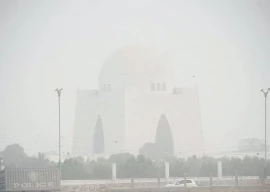
KARACHI:
I counted 13 billboards advertising new lawn designs on my way to work today, each of which was from a different company and designer. Not surprising, since lawn fabric has become a huge industry of its own now and is said to be worth several billions.
“Seven hundred million metres of lawn fabric is purchased annually in Pakistan,” informed Textile Links CEO Farrukh Mian who connects textile companies with designers and models. The company handles clients such as Asim Jofa, HSY, Vaneeza, Sonya Batla and others.
“Fifty-three per cent of Pakistan’s 180 million population is female, and with our hot weather and traditional attire being shalwar kameez, it is safe to say that every member of the gender has at least one suit made up of lawn fabric,” he said, adding that when considered this way, the industry revenue of up to Rs800 million is completely believable.
So what has made lawns so desirable and popular? “Mostly better educated women, awareness of fashion trends, better disposable income, good quality, and attractive designs of expensive fabrics,” Mian answered firmly.
The expert has been associated with both, the textile and fashion industry for the past 25 years. “Designers only endorse their names for different textile firms. The real investment and work is done by the company these designers collaborate with,” he said, when asked the reason for the sudden rise in designer labels.
“It is all about trends in the fashion industry. If someone is doing something and is successful, others will follow suit,” he explained. Mian, however, went on to say that next year, the number of designers launching their lawn labels is likely to drop.
“It is not only about recognised names, quality and comfort are equally important as women are more aware of what they are buying now, and some designers have fallen flat in this regard,” he shared. The competition, too, is tough, he added.
Top models Iman Ali and Vaneeza Ahmed endorsed some of Mian’s views. Ahmed, who is preparing to launch her latest wear next month, said that designers were only meeting the demand of consumers as there is a huge potential for quality wear in the local market.
Higher employment, more revenues
This profitable industry has created better employment opportunities too. With event management companies mushrooming in the country, advertising getting wittier by the day and promotions literally roller-skating (remember Strepsils anyone?) on the roads, thousands of jobs have been created.
“Recession may be for bankers and financial institutions. We are doing just fine with our fashion industry performing so well,” said Tooba Tariq, a final year student of The Indus Institute of Fashion Design.
She said that many students are “zapped up by textile firms or their designs purchased” when their talent is obvious. There is not a lot of money initially, but there is huge potential to make it big if you strike the right cord with the right people, she said.
Tariq said that some of her friends had been hired by renowned textile companies while they were still studying and they were making Rs20,000-plus in the beginning of their careers. “Many of us also do home-based designing and catering to orders. If we get good orders, then we can easily make from as little as Rs10,000 to as high as Rs70,000 by just sitting at home,” she added.
Rising prices
Farrukh Mian said that rising cotton prices had also jacked up the industry’s revenue as prices of lawn fabric have shot up by almost 30-40 per cent. In 2009, cotton was available for 65 cents a pound in the New York Cotton Exchange, which has shot up to $1.95 per pound in 2010-11.
“The impact of rising cotton prices was felt globally and even Pakistan’s cotton prices shot up to Rs13,000 a maund,” he said. Furthermore, prices of electricity, gas and transportation have also increased significantly, which led to higher costs of doing business. “It is always the end-user who has to face the brunt, and our lawn suit prices shot up considerably as manufacturers seldom compromise on their profits,” he stated. He explained that with changing fashion, the volume of unstitched cloth being sold has also risen.
“Today’s fashion is long-length kameez, therefore, instead of the traditional 7.5 metres of fabric, 9.5 metres are sold so the consumers can have their clothes stitched according to the trend,” he said.
Mian informed that unbranded lawn suits, which were priced at Rs350-500 per suit in 2009, were now being sold for Rs750-1000, while branded lawn designers had also been compelled to increase prices to a minimum of Rs3,000, from the earlier starting figure of Rs1200 per suit on average.
According to a short informal survey of local markets, most retailers of both branded and unbranded clothes said that wholesale prices of lawn have increased 40 per cent compared to previous years, which when passed on to consumers showed a difference of up to 70 per cent.
Marketing, advertising and event management
Catwalk Productions owner and CEO Frieha Altaf said that allied industries, linked to the lawn manufacturing and designing industry, have also made it big. “Millions are spent on advertising and marketing by these firms. There are billboards, photo shoots, magazines, newspapers, television, special catalogues... the list goes on,” she said.
“Just to give you an idea, let me tell you that one billboard alone can cost between Rs12 and Rs15 million, and the entire city is dotted with these, apart from media advertising,” she added. Altaf went on to say that with increasing competition, various companies have stressed even more the need of advertising this year in comparison with previous years. A marketing executive with a leading public relations firm said that on an average Rs500 million is spent by all major firms on various forms of advertisements.
And it just does not end here. Event management is the new fad. Millions are spent on launching newly designed wears and making sure that it is the talk of the town. “Designers lie to get what they want. If they have one print sold out, they will say the entire exhibition has been sold out. If the crowd is less, they play around with the area space to make it seem like a scramble,” said Altaf.
However, like Mian, this expert of the fashion industry also thinks that it is not going to last. “Quality will always reign supreme. Only top names with guarantee of their products will remain, while the rest will disappear,” she stated.
Better exports, brand recognition
Farrukh Mian informed that designers have taken their labels to foreign countries where South Asians, mostly Pakistanis, are wearing them, consequently promoting the local industry.
Overall year-on-year exports have increased 20 per cent, exclusively due to improved promotion of brands, he stated.
“Many of the designers are stocking abroad,” said Mian, while naming US, UK and Dubai as top foreign destinations. People living abroad are demanding lawns of certain designers and they have been sold out. This adds to the hype for the products, he said.
Published in The Express Tribune, March 4th, 2011.






















































COMMENTS (2)
Comments are moderated and generally will be posted if they are on-topic and not abusive.
For more information, please see our Comments FAQ